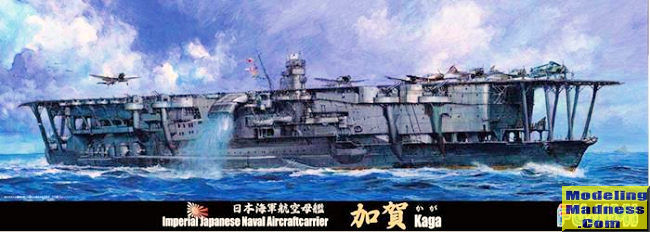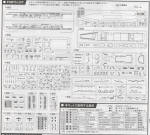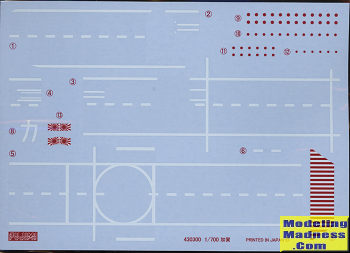
Fujimi 1/700 IJN Aircraft Carrier Kaga
| KIT #: | 430300 |
| PRICE: | 2800 yen SRP |
| DECALS: | One option |
| REVIEWER: | Scott Van Aken |
| NOTES: | 2012 boxing |

| HISTORY |
Kaga (加賀) was an aircraft carrier built for the Imperial Japanese Navy (IJN) and was named after the former Kaga Province in present-day Ishikawa Prefecture. Originally intended to be one of two Tosa-class battleships, Kaga was converted under the terms of the Washington Naval Treaty to an aircraft carrier as the replacement for the battlecruiser Amagi, which had been damaged during the 1923 Great Kanto earthquake. Kaga was rebuilt in 1933–35, increasing her top speed, improving her exhaust systems, and adapting her flight decks to more modern, heavier aircraft.
The ship figured prominently in the development of the IJN's carrier striking force doctrine, which grouped carriers together to give greater mass and concentration to their air power. A revolutionary strategic concept at the time, the employment of the doctrine was crucial in enabling Japan to attain its initial strategic goals during the first six months of the Pacific War.
Kaga's aircraft first supported Japanese troops in China during the Shanghai Incident of 1932 and participated in the Second Sino-Japanese War in the late 1930s. With other carriers, she took part in the Pearl Harbor raid in December 1941 and the invasion of Rabaul in the Southwest Pacific in January 1942. The following month her aircraft participated in a combined carrier airstrike on Darwin, Australia, helping secure the conquest of the Dutch East Indies by Japanese forces. She missed the Indian Ocean raid in April as she had to return to Japan for permanent repairs after hitting a reef in February.
Following repairs, Kaga rejoined the 1st Air Fleet for the Battle of Midway in June 1942. After bombarding American forces on Midway Atoll, Kaga and three other IJN carriers were attacked by American aircraft from Midway and the carriers Enterprise, Hornet, and Yorktown. Dive bombers from Enterprise severely damaged Kaga; when it became obvious she could not be saved, she was scuttled by Japanese destroyers to prevent her from falling into enemy hands. The loss of four large attack carriers, including Kaga at Midway, was a crucial setback for Japan, and contributed significantly to Japan's ultimate defeat. In 1999, debris from Kaga including a large section of the hull was located on the ocean floor at a depth in excess of 5,000 meters (16,404 ft); 350 miles (560 km) northwest of Midway Island. The main part of the carrier's wreck has not been found.
| THE KIT |
 This
is a recent tooling from Fujimi and is so much nicer than their very early kit
that you should consider getting rid of it. The molding is excellent and the
parts count is really quite impressive for a 1/700 kit. Engraved panel lines are
not a big thing with ships, but where they are present (as in the flight deck)
they are well done.
This
is a recent tooling from Fujimi and is so much nicer than their very early kit
that you should consider getting rid of it. The molding is excellent and the
parts count is really quite impressive for a 1/700 kit. Engraved panel lines are
not a big thing with ships, but where they are present (as in the flight deck)
they are well done.
This is a waterline kit and so you do not get a lower
hull. The 1/700 waterline trend started in Japan and quickly became quite
popular with folks who wanted a nice collection of ships and did not have much
space. What is different in the more modern ships is the improved quality of the
detail, the thinner detail parts, the lack of a weight and the fact that the
waterline piece is no longer red. The aircraft are also treated differently,
being produced from clear plastic so you can have some semblance of canopies.
Speaking of which, you get two Vals, two Kates and two Zeros.

The hull itself is built up of left and right sides with braces that fit inbetween them to keep things stiff. There are subdecks fore and aft, both sides having considerable bracing. The Kaga used to have three flight decks, but during a refit the upper one was lengthened and the other two eliminated. These ships are externally very busy with a lot of sponsons of different sizes holding things like lifeboats and AA guns. The elevator holes in the flight deck are open and it appears that one could model the elevators down, even though there is no hangar deck. However, there are plastic blocks which are inserted in the wells to hold the elevator at flight deck level.
Instructions are very well done and provide the minimal color information needed while building. The decal sheet includes all the deck markings you will need, including the red striped area at the back of the flight deck. You also get insignia for the aircraft.
| CONCLUSIONS |
This is not a weekend build and is one that the modeler needs to construct with care. Thanks to all the small parts, I'd not recommend this to the youngster or those who think their age precludes working with little bits. For the rest, the end result will be a superb model of this important Japanese warship.
| REFERENCES |
https://en.wikipedia.org/wiki/Japanese_aircraft_carrier_Kaga
September 2017 Copyright
ModelingMadness.com. All rights reserved. Thanks to Kevin Dolin for sending in the preview kit.
If you would like your product reviewed fairly and fairly quickly, please contact the editor or see other details in the
Note to
Contributors. Back to the Main Page
Back to the Review
Index Page
Back to the Previews Index Page